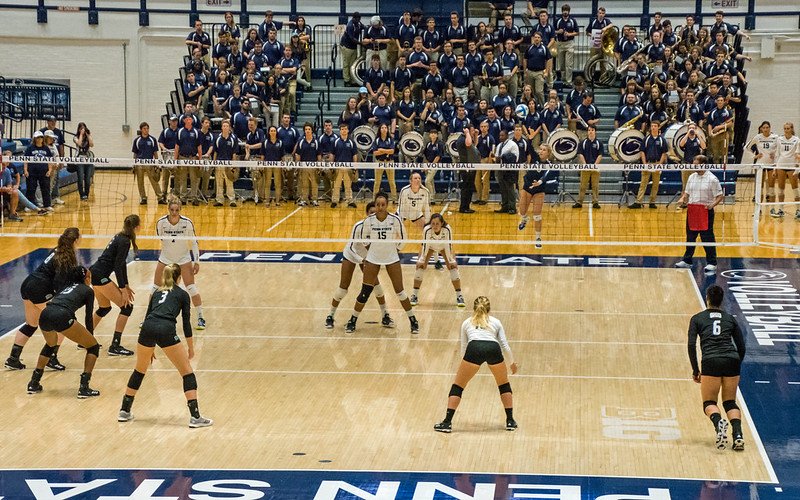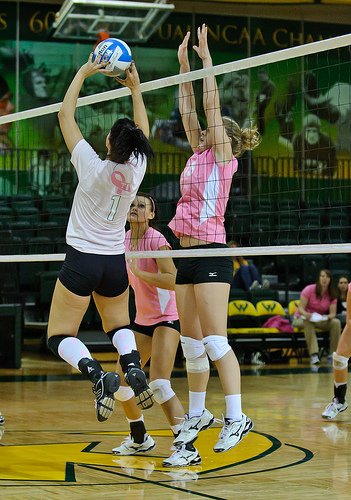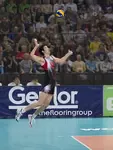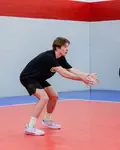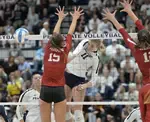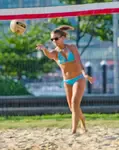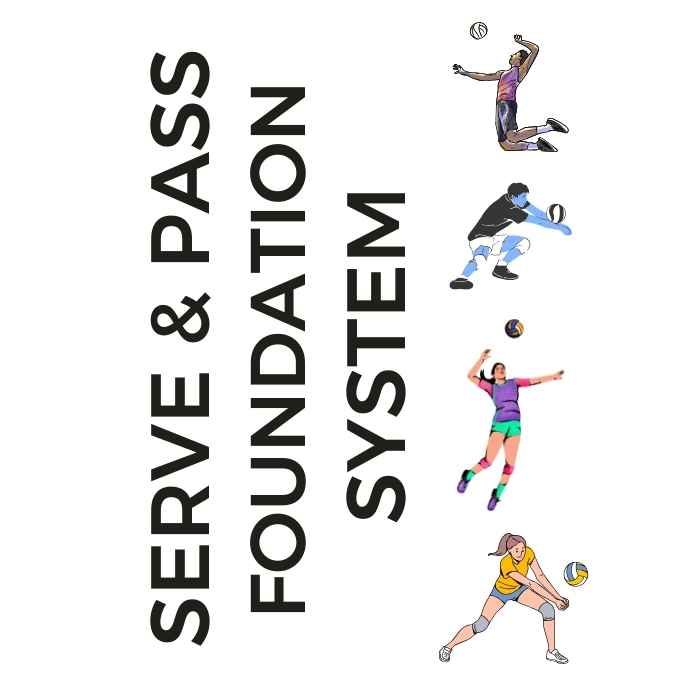
Serve + Pass Foundation System: The Complete Skills Arsenal The two-skill mastery system that transforms inconsistent players into the athletes coaches build their lineups around. Stop Struggling With The Two Most Important Skills In Volleyball!
- Improve Your Volleyball with Coach April
- Basic Volleyball Skills
- How To Learn Volleyball Rotations
Here's How To Learn Volleyball Rotations Positions and the 6 Zones
Here's how to learn the volleyball rotations? The 6 volleyball zones or positions that players rotate in and out of depending on the offense their team runs.
Here's an explanation of the 6 rotation volleyball zones, specifically the rotational positions that players rotate in and out of, on an indoor court, regardless of the positions they play, during a match.
Let's get started.
There are six positions, also called zones on an indoor court.
They are invisible and they form the key elements of each rotation, which is a part of the game you should familiarize yourself before you start to seriously learn how to play volleyball.
These are areas invisibly divided into six sections on the court that you just have to know about as a player.
Here's How To Learn Volleyball Rotations Positions and the 6 Zones
Front Row and Back Row
As I was saying, there are six rotation volleyball positions on a court, three are in the back court also referred to as the back row.
Three zones or positions are in the front court which is more commonly called the front row.
Also, remember the front row and the back row are divided by the ten foot line, which is clearly visible on the court.
When you rotate in volleyball you move clockwise, each player moving into one rotational position to their left when they're in the backrow and one rotational position to their right when they're in the front row, after their team has won a rally and the right to serve.
Here's How To Learn Volleyball Rotations Positions and the 6 Zones
Locations and Abbreviations
There are 6 rotation volleyball positions on the court that each player rotates in and out of regardless of what role or position they play.
Here is the list of rotational volleyball zones in clockwise order, starting with Position 1, RB, Right Back.
Backrow Rotation Volleyball Positions
- Position 1 is Right Back - RB
- Position 6 is Middle Back - MB
- Position 5 is Left Back - LB
Front Row Rotation Volleyball Positions
- Position 4 is Left Front - LF
- Position 3 is Middle Front - MF
- Position 2 is Right Front - RF
Here's How To Learn Volleyball Rotations Positions and the 6 Zones
Player Positions
There are specialized areas that each player position plays in.
Setters and Opposites
- Position 2 when they're in the front row
- Position 1 when they are on defense in the backrow
Middles/Liberos
- Position 3 when they're in the front row Position 6 if they stay in the backrow but if they're rotated out and replaced by a libero, the libero then plays defense in middle back
- On more teams now the libero plays left back in Position 5 so the left side/wing spiker can play defense in Position 6 and hit from the backrow from there as well.
Left Sides/Wing Spikers
- Position 4 when they're in the front row
- Position 5/6 when they're in the backrow. This depends on the coach and whether he wants the wing spiker to attack from the middle back position 6 on the court, when they are backrow
Once the whistle blows and the server has served the ball, then each player from their rotational position on the court switches to play in their specialized position on the court for the duration of the rally.
So when the whistle blows and the server serves then setters go to the right side of the court, if they are front row they switch to Position 2, if back row they switch with whoever is in rotational Position 1 to play in their specialized position on the right side.
Left side players will switch to play on the left sides of the court.
Middles and liberos switch to play in the middle positions on the court (with some exceptions for liberos.)
Once the rally ends they go back to their rotational position on the court.
If they won the rally they rotate one position.
If they lost the rally they go back to their serve receive offense pattern and receive serve again.
In the photo above Illinois State Redbirds Blockers On Defense Ready To Switch After Their Server Serves The Ball
#2 Will Go To Position 4 on the court, switching from her rotational position on the court to her specialized volleyball position because she's the left side hitter.
The Player Behind Her Will Go To Zone 2 because she is the setter or the right side hitter;
#21 The Middle Blocker Will Stay In Zone 3 because she's already in her rotational position on the court (MF) and doesn't need to switch with anybody after her server serves.
(photo by Bill Shaner)
The more you play, the more you will become familiar with what happens in each position and where you need to be on the court.
Here's My Detailed Explanation of Each Volleyball Rotation
Understanding the specific responsibilities and movements of players in each rotation is crucial for mastering volleyball rotations.
In this section, I provide detailed explanations for each rotation, outlining the positioning and transitions players need to be aware of during rotations.
Rotation 1: Right Back (RB)
- Player in right back starts in the serving position.
- After serving, they transition to position 6 in the back row.
- When the team wins a rally, they rotate to position 1, which is right back again.
Rotation 2: Middle Back (MB)
- Player in middle back starts in position 6 in the back row.
- After the rally, they transition to position 5 in the back row.
- Winning a rally moves them back to position 6 in the back row.
Rotation 3: Left Back (LB)
- Player in left back begins in position 5 on the back row.
- After the rally, they move to position 4 in the front row.
- Upon winning a rally, they rotate back to position 5 in the back row.
Rotation 4: Left Front (LF)
- Player in left front starts in position 4 on the front row.
- After the rally, they transition to position 3 on the front row.
- If the team wins the rally, they rotate to position 4 again.
Rotation 5: Middle Front (MF)
- Player in middle front begins in position 3 on the front row.
- Once the rally ends, they transition to position 2 on the front row.
- If the team wins the rally they rotate to position 3 again.
Rotation 6: Right Front (RF)
- Player in right front starts in position 2 on the front row.
- After the rally, they transition to position 1 in the back row.
- If the team wins the rally, they rotate back to position 2 on the front row.
By understanding these rotations and the corresponding positions, players can effectively transition and execute their roles during a volleyball match.
It is essential to practice these rotations to ensure smooth and efficient gameplay.
Strategies for Effective Rotations
Executing rotations smoothly and efficiently is essential for a well-coordinated volleyball team.
In this section, I explore some valuable tips and strategies to ensure effective rotations, including communication and positioning adjustments during transitions.
1. Communication is Key
- Establish clear communication channels among teammates to relay important information during rotations.
- Use verbal cues and hand signals to communicate rotation changes and positioning adjustments.
- Encourage constant communication to keep everyone on the same page and minimize confusion.
2. Maintain Awareness
- Continuously scan the court to anticipate rotations and positioning changes.
- Stay alert to your teammates' movements and adjust your positioning accordingly.
- Develop court awareness to ensure smooth transitions and seamless rotations.
3. Practice Timing and Tempo
- Timing is crucial in executing rotations smoothly. Practice the timing of movements and transitions to minimize delays and maintain the team's tempo.
- Emphasize quick and efficient rotations to prevent opponents from capitalizing on any gaps or confusion.
4. Anticipate and Adjust
- Anticipate potential obstacles or challenges during rotations and mentally prepare to make the necessary adjustments.
- Adapt quickly to unexpected changes in play, such as opponents' strategic adjustments or defensive positioning.
5. Utilize Positioning Techniques
5. Utilize Positioning Techniques:
- During transitions, use proper footwork and body positioning to get into the correct rotational position efficiently.
- Maintain a low balanced stance to face the play, allowing for quick reactions and effective decision-making.
6. Practice and Repetition
- Regularly practice rotations to build familiarity and muscle memory.
- Conduct drills that simulate different rotation scenarios, enabling players to adapt to various game situations.
By implementing these strategies, players can execute rotations smoothly and efficiently, leading to better overall team performance on the court.
Effective communication, awareness, timing, and practice are key elements in successful rotations.
Let Me Explain The Specialized Positions on the Court
In addition to understanding the general rotations, it's important to grasp the roles and responsibilities of specialized positions.
Let's take a closer look at three key positions – setters, liberos, and middle blockers – and how their positioning and movements differ during rotations.
Setters:
- Setters play a crucial role in orchestrating the team's offense by strategically placing the ball for hitters to attack.
- In rotations, setters typically occupy position 2 when they are in the front row and position 1 when they are on defense in the back row.
- They have a greater responsibility to transition quickly between the net and the back row to ensure efficient ball distribution.
- Liberos are defensive specialists primarily responsible for receiving serves and making accurate passes to initiate the offense.
- During rotations, liberos often start in position 5, playing in the left back zone, providing stability and strong defensive coverage for cross court attacks especially which happen more often in a match than line attacks
- They have the flexibility to replace a middle blocker and play defense in the middle back position (position 6) if necessary.
- Middle blockers are essential for blocking opposing hitters and creating a strong defensive presence at the net.
- In rotations, middle blockers start in position 3 when they are in the front row, playing a pivotal role in blocking and attacking from the middle.
- When they rotate to the back row, they often transition to the left back position (position 5) for defensive coverage.
These specialized positions require specific skill sets and unique movements within rotations. Setters focus on precision and decision-making, liberos excel in defensive consistency, and middle blockers combine blocking and attacking prowess.
Understanding these roles and their positioning during rotations is crucial for effective teamwork and maximizing the strengths of each specialized player.
Volleyball Positions:
Where Do I Go From Here?
Good times! Where do you need to go now? Here are three options:
- Learn more about the various Rotations.
- Follow the suggested reading on our Sitemap page Learning How To Play (Sitemap)
- Or visit the pages in the Volleyball Positions section in the drop down menu at the top of the page.
If your athlete struggles with consistent serve receive, gets subbed out, or is overlooked for playing time—this is the fix you’ve been looking for.

Struggling with passing consistency?
I help talented passers tired of getting pulled from games because of inconsistent serve receive skills BUILD passing confidence without expensive private lessons using the same 3-step system that's helped dozens of my athletes get recruited.
Download my eBook for $17.99 and start building the passing confidence that keeps you on the court—and gets you seen by college coaches.
From Lady Vol to Legend: Coach April Produces Powerful Passionate Players...is that you?
What Are You Looking For?
Click to Download Your Pre Serving Ritual Mastery Checklist pdf:
🎯Volleyball Pre Serving Ritual Guide -
Players! Learn How To Transform Your Serve from Weak to Weapon
Click to Download Your Parent's Volleyball Serving Checklist pdf
🎯Parent's Volleyball Serving Checklist Guide
Parents! Help Your Player Develop Championship Serves (Even If You've Never Played)

Hi there!
Thanks for stopping by. Hope you learned something today that will help you reach your volleyball goals.
Be sure to subscribe to my email newsletter so you can learn more each week!
Stay strong! Stay motivated!
-Coach April

SUSCRIBE to my email newsletter below!
 Click to learn more about the weekly volleyball classes and clinics or email info@imrpoveyourvolley.com for information
Click to learn more about the weekly volleyball classes and clinics or email info@imrpoveyourvolley.com for informationCongratulations to my seven Boys-18s Vegas Volley club players who played in two state championship finals yesterday, the 3A and 5A State champinship finals at Sunrise Mountain High School.
TOURNAMENT CHAMPIONS!
A-1 Vegas Volley VBC
In It To Win It Tournament
May 2 - 4, 2025 Tournament
Gold Medalists
18s Premier Division
Vegas Volleyball's Unsung Heroes: Celebrating Moms with Peace Love Volleyball Shirts
Ready to energize your volleyball mom journey?
Subscribe to my 'Producing Powerful Passionate Peaceful Players' email list above on ImproveYourVolley.com.
You'll receive energy-boosting tips, exclusive insights from me, Coach April Chapple on maintaining momentum in volleyball.
Let's power up the Vegas volleyball scene together!
Recent Articles
-
5 Essential Serving Tips from Tennessee's #2 Career Aces Record Holder
Dec 09, 25 11:39 PM
I've identified the 5 essential serving tips that separate confident servers from struggling ones and you'll serve with the confidence that creates aces -
The Volleyball Toss How Consistent Is Your Ball Toss Before You Serve?
Dec 07, 25 12:29 AM
The volleyball toss for the overhand serve needs to consistently be two feet up in the air and one foot in front of front foot which puts the ball in front of your serving arm. -
Shop Small: Real Volleyball Training With + Results From A Real Coach
Dec 03, 25 10:30 AM
Support a woman-owned business. Get training from a former elite pro with 13+ years coaching experience. Ditch the big box store--invest in proven results.









